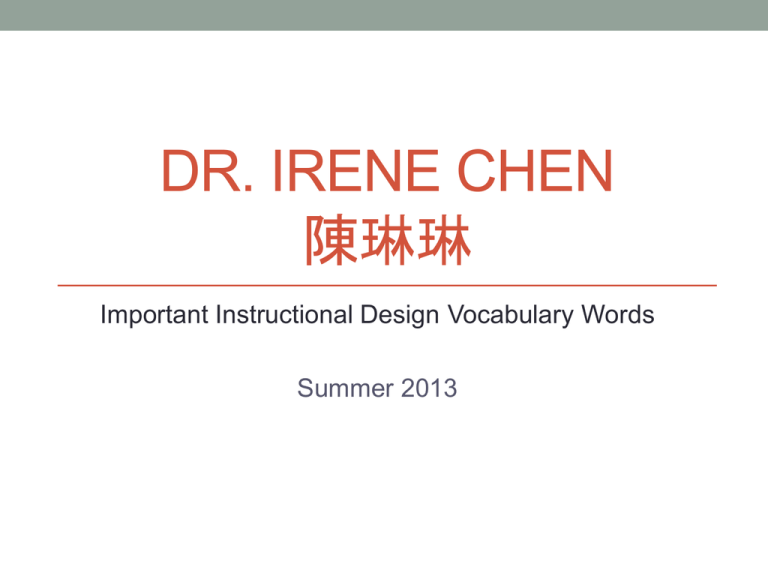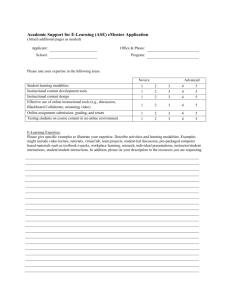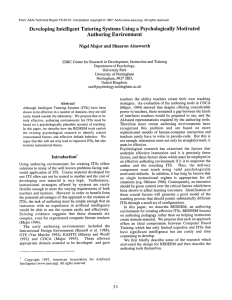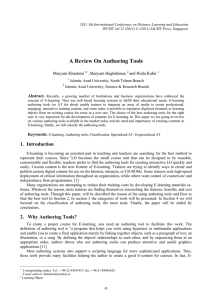Authoring tool
advertisement

DR. IRENE CHEN 陳琳琳 Important Instructional Design Vocabulary Words Summer 2013 A • ADA: The Americans with Disabilities Act is a U.S. law passed in 1990 that prohibits discrimination against people with disabilities. This Act gives civil rights protection to individuals with disabilities and impacts businesses and organizations as both service providers and employers. http://instructionaldesignandtraining.blogspot.com/2011/04/i d-vocabulary.html A • ADHD (Attention Deficit Hyperactivity Disorder): a disorder in which a student may exhibit poor concentration, plus impulsivity and hyperactivity. • Adult Learning Theory (Andragogy): a theory pioneered by Malcolm Knowles, which describes learning motivators and how they differ in adults and children. Adults are more self-directed and autonomous in their learning, and bring more life experience to the learning process than children. A • Assistive Technology: equipment or software that enables people with disabilities to accomplish daily living tasks, assist them in communication, education, work or recreation activities. Some examples include screen readers and voice input software. • Authoring tool: a software application used by teachers and instructional designers to create e-Learning courseware. Some examples of authoring tools include instructionally focused authoring tools, web-authoring and programming tools, knowledge-capture systems, and textand file-creation tools. B • Blended Learning: a combination of learning methods, such as e-Learning, face-to-face instruction, group and individual study, and coaching. • Bloom’s Taxonomy: a model that organizes thinking processes into six levels of complexity: knowledge, comprehension, application, analysis, synthesis, and evaluation. • Branching: progressing through a path of tutorial subject matter based on the learner’s responses to a series of questions. C • Chunk: (noun) a distinct portion of content that often consists of several learning topics grouped together. (verb) to divide content into separate portions or combine smaller content elements into groups. • Cognitive Apprenticeship: its two main forms involve students 1) working with instructors on problems that may be too difficult to tackle without aid and 2) focusing on real-world problems, to reiterate the material and increase understanding of the subject. C • Collaboration Technology: a secure, self-contained environment that allows people at different locations to communicate and work with each other using common software and services. This technology includes document management, application sharing, presentation development, whiteboarding, delivery, chat, and more. • Collaborative Learning: involves two or more students working together, to better understand a subject through activities and discussion. C • Constructivist Models: models based on the philosophy that knowledge must be constructed by each individual and cannot be mechanically transferred from teachers to students. Therefore, students learn only when connections are built between their existing conceptual networks and the new material. • Cooperative Learning Model: a learning approach where students share knowledge with each other through a variety of arrangements. Cooperative learning includes five components: positive interdependence, face-to-face interactions, individual accountability, some structured activity, and team-building skills. C • Courseware: any type of instructional or educational program delivered via a software program or over the Internet. D • Digital Divide: a popular term for the gap between those who can and cannot afford (or access) computers and related technologies. F • F2F (Face-to-Face): a term used to describe traditional classroom environments. Facilitative Questioning: an approach whereby a teacher or counselor poses openended questions to students, to allow them to explore ideas that may be complex or emotionally difficult. There are no right or wrong answers in this approach. • Facilitator: an online instructor who assists, directs, and stimulates learning during an online course. H • Higher Order Thinking Skills: any thinking that goes beyond remembering basic facts. Two important reasons to improve higher-order thinking skills are 1) to enable students to apply facts to solve real world problems and 2) to improve the retention of information. I • Individualized Instruction: students systematically designing individual learning activities and materials, based on their interests, abilities and experiences. • Instructional Design: systematic instructional needs assessment, development, evaluation, implementation, and maintenance of materials and programs. N • Navigation: moving from website to website on the World Wide Web or an online site that may not be part of the World Wide Web, including an intranet site or an online course. 2) a web site's or course's information architecture that enables users to steer their way though the site. • Non-Examples: a technique used in direct instruction to help learners distinguish between related ideas. P • Page Turner: a derogatory term for e-Learning sites that offer little or no graphics or interaction, and consist mostly of simple text pages. • PBL (Problem-Based Learning; 問題導向學習): an inductive teaching method where no direct instruction takes place. The teacher poses authentic (real-world) problems and students learn content and skills as they work together to solve the problems. • Portfolio: samples of a student's work, carefully selected by the student and accompanied by formal criteria against which readers can judge the material. • Prototype原型- a prototype is a physical model of a product. A miniature version of what a new car would look like is an example of a prototype. Prototypes can be working or nonworking. R • Repurpose重用: to reuse content by restructuring it for a different function than was originally intended. • Rich Content: high-quality course or webpage material, often created using sophisticated design techniques that emphasize the intended message. • Rubrics: a code or set of codes governing an action, activity or project. S • Storyboard: an outline of a multimedia project in which each page represents a screen to be designed and developed. http://www.instructionaldesign.org/storyboarding.html S • S.W.O.T. Analysis: Analysis of Strengths, Weaknesses, • • • • Opportunities and Threats (SWOT) in a situation. Scaffolding: providing temporary support, to build on a student's existing knowledge through examples and explanations until help is no longer needed. Scalability: the degree to which a computer application or component may be expanded in size, volume or number of users served, and continue to function properly. Sequencing: the process of organizing concepts in the order in which they naturally occur. SME (Subject-Matter Expert;內容專家): an individual who is recognized as having expert knowledge about, and skills in, a subject area. S • Spiral Sequencing: an instructional approach in which ideas are presented to students beginning with simple concepts, and then periodically revisited and expanding upon, as appropriate for the learners' cognitive levels. • Stakeholder: a person with a vested interest in the successful completion of a project. Stakeholders in eLearning often include developers, facilitators, users, training managers, and customers. All Definitions based on: • http://instructionaldesignandtraining.blogspot.com/2011/0 4/id-vocabulary.html Visualization: 吳奇隆PO「今天長這樣」 無聊變流行 今天長這樣 7/4/2013 文字雲 http://timc.idv.tw/wordcloud/







